Hongyin Zhang
Balancing Signal and Variance: Adaptive Offline RL Post-Training for VLA Flow Models
Sep 04, 2025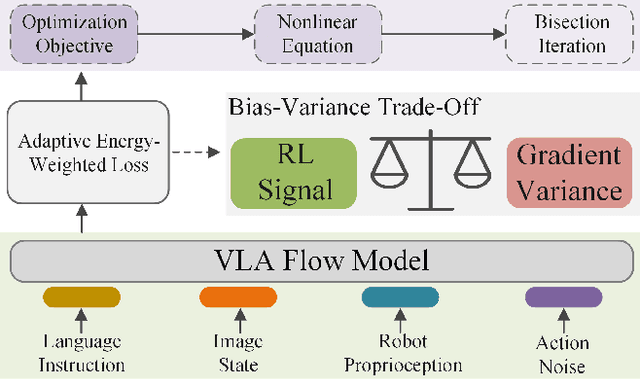

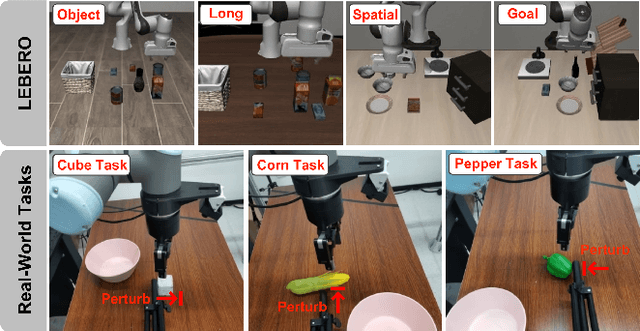

Abstract:Vision-Language-Action (VLA) models based on flow matching have shown excellent performance in general-purpose robotic manipulation tasks. However, the action accuracy of these models on complex downstream tasks is unsatisfactory. One important reason is that these models rely solely on the post-training paradigm of imitation learning, which makes it difficult to have a deeper understanding of the distribution properties of data quality, which is exactly what Reinforcement Learning (RL) excels at. In this paper, we theoretically propose an offline RL post-training objective for VLA flow models and induce an efficient and feasible offline RL fine-tuning algorithm -- Adaptive Reinforced Flow Matching (ARFM). By introducing an adaptively adjusted scaling factor in the VLA flow model loss, we construct a principled bias-variance trade-off objective function to optimally control the impact of RL signal on flow loss. ARFM adaptively balances RL advantage preservation and flow loss gradient variance control, resulting in a more stable and efficient fine-tuning process. Extensive simulation and real-world experimental results show that ARFM exhibits excellent generalization, robustness, few-shot learning, and continuous learning performance.
Multi-Task Multi-Agent Reinforcement Learning via Skill Graphs
Jul 09, 2025Abstract:Multi-task multi-agent reinforcement learning (MT-MARL) has recently gained attention for its potential to enhance MARL's adaptability across multiple tasks. However, it is challenging for existing multi-task learning methods to handle complex problems, as they are unable to handle unrelated tasks and possess limited knowledge transfer capabilities. In this paper, we propose a hierarchical approach that efficiently addresses these challenges. The high-level module utilizes a skill graph, while the low-level module employs a standard MARL algorithm. Our approach offers two contributions. First, we consider the MT-MARL problem in the context of unrelated tasks, expanding the scope of MTRL. Second, the skill graph is used as the upper layer of the standard hierarchical approach, with training independent of the lower layer, effectively handling unrelated tasks and enhancing knowledge transfer capabilities. Extensive experiments are conducted to validate these advantages and demonstrate that the proposed method outperforms the latest hierarchical MAPPO algorithms. Videos and code are available at https://github.com/WindyLab/MT-MARL-SG
ReinboT: Amplifying Robot Visual-Language Manipulation with Reinforcement Learning
May 12, 2025Abstract:Vision-Language-Action (VLA) models have shown great potential in general robotic decision-making tasks via imitation learning. However, the variable quality of training data often constrains the performance of these models. On the other hand, offline Reinforcement Learning (RL) excels at learning robust policy models from mixed-quality data. In this paper, we introduce Reinforced robot GPT (ReinboT), a novel end-to-end VLA model that integrates the RL principle of maximizing cumulative reward. ReinboT achieves a deeper understanding of the data quality distribution by predicting dense returns that capture the nuances of manipulation tasks. The dense return prediction capability enables the robot to generate more robust decision-making actions, oriented towards maximizing future benefits. Extensive experiments show that ReinboT achieves state-of-the-art performance on the CALVIN mixed-quality dataset and exhibits superior few-shot learning and out-of-distribution generalization capabilities in real-world tasks.
TDMPBC: Self-Imitative Reinforcement Learning for Humanoid Robot Control
Feb 24, 2025Abstract:Complex high-dimensional spaces with high Degree-of-Freedom and complicated action spaces, such as humanoid robots equipped with dexterous hands, pose significant challenges for reinforcement learning (RL) algorithms, which need to wisely balance exploration and exploitation under limited sample budgets. In general, feasible regions for accomplishing tasks within complex high-dimensional spaces are exceedingly narrow. For instance, in the context of humanoid robot motion control, the vast majority of space corresponds to falling, while only a minuscule fraction corresponds to standing upright, which is conducive to the completion of downstream tasks. Once the robot explores into a potentially task-relevant region, it should place greater emphasis on the data within that region. Building on this insight, we propose the $\textbf{S}$elf-$\textbf{I}$mitative $\textbf{R}$einforcement $\textbf{L}$earning ($\textbf{SIRL}$) framework, where the RL algorithm also imitates potentially task-relevant trajectories. Specifically, trajectory return is utilized to determine its relevance to the task and an additional behavior cloning is adopted whose weight is dynamically adjusted based on the trajectory return. As a result, our proposed algorithm achieves 120% performance improvement on the challenging HumanoidBench with 5% extra computation overhead. With further visualization, we find the significant performance gain does lead to meaningful behavior improvement that several tasks are solved successfully.
GEVRM: Goal-Expressive Video Generation Model For Robust Visual Manipulation
Feb 13, 2025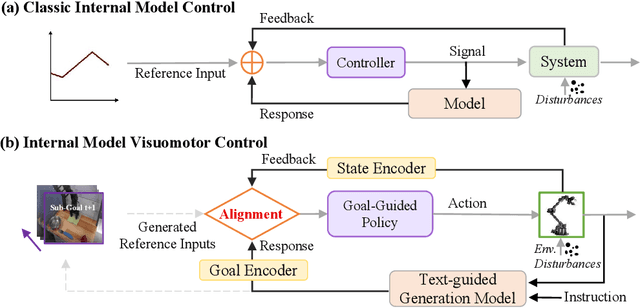
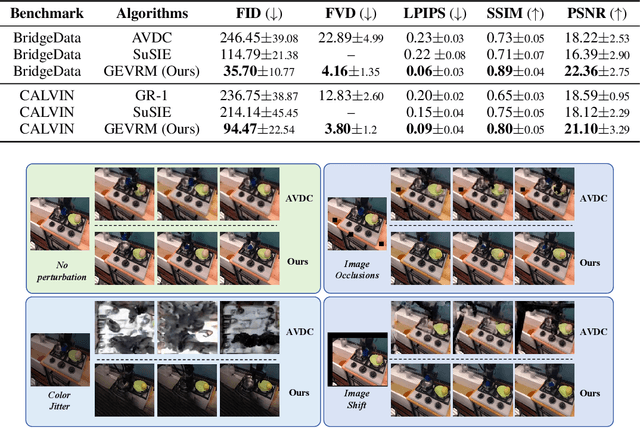
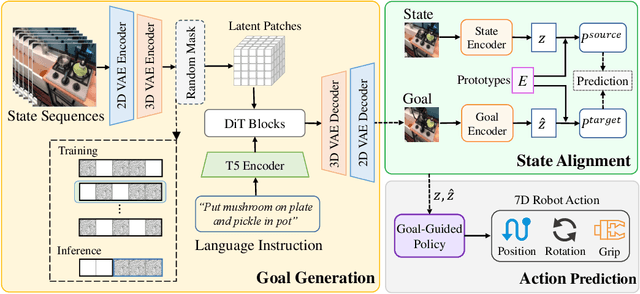

Abstract:With the rapid development of embodied artificial intelligence, significant progress has been made in vision-language-action (VLA) models for general robot decision-making. However, the majority of existing VLAs fail to account for the inevitable external perturbations encountered during deployment. These perturbations introduce unforeseen state information to the VLA, resulting in inaccurate actions and consequently, a significant decline in generalization performance. The classic internal model control (IMC) principle demonstrates that a closed-loop system with an internal model that includes external input signals can accurately track the reference input and effectively offset the disturbance. We propose a novel closed-loop VLA method GEVRM that integrates the IMC principle to enhance the robustness of robot visual manipulation. The text-guided video generation model in GEVRM can generate highly expressive future visual planning goals. Simultaneously, we evaluate perturbations by simulating responses, which are called internal embeddings and optimized through prototype contrastive learning. This allows the model to implicitly infer and distinguish perturbations from the external environment. The proposed GEVRM achieves state-of-the-art performance on both standard and perturbed CALVIN benchmarks and shows significant improvements in realistic robot tasks.
QUART-Online: Latency-Free Large Multimodal Language Model for Quadruped Robot Learning
Dec 23, 2024Abstract:This paper addresses the inherent inference latency challenges associated with deploying multimodal large language models (MLLM) in quadruped vision-language-action (QUAR-VLA) tasks. Our investigation reveals that conventional parameter reduction techniques ultimately impair the performance of the language foundation model during the action instruction tuning phase, making them unsuitable for this purpose. We introduce a novel latency-free quadruped MLLM model, dubbed QUART-Online, designed to enhance inference efficiency without degrading the performance of the language foundation model. By incorporating Action Chunk Discretization (ACD), we compress the original action representation space, mapping continuous action values onto a smaller set of discrete representative vectors while preserving critical information. Subsequently, we fine-tune the MLLM to integrate vision, language, and compressed actions into a unified semantic space. Experimental results demonstrate that QUART-Online operates in tandem with the existing MLLM system, achieving real-time inference in sync with the underlying controller frequency, significantly boosting the success rate across various tasks by 65%. Our project page is https://quart-online.github.io.
RSG: Fast Learning Adaptive Skills for Quadruped Robots by Skill Graph
Nov 10, 2023Abstract:Developing robotic intelligent systems that can adapt quickly to unseen wild situations is one of the critical challenges in pursuing autonomous robotics. Although some impressive progress has been made in walking stability and skill learning in the field of legged robots, their ability to fast adaptation is still inferior to that of animals in nature. Animals are born with massive skills needed to survive, and can quickly acquire new ones, by composing fundamental skills with limited experience. Inspired by this, we propose a novel framework, named Robot Skill Graph (RSG) for organizing massive fundamental skills of robots and dexterously reusing them for fast adaptation. Bearing a structure similar to the Knowledge Graph (KG), RSG is composed of massive dynamic behavioral skills instead of static knowledge in KG and enables discovering implicit relations that exist in be-tween of learning context and acquired skills of robots, serving as a starting point for understanding subtle patterns existing in robots' skill learning. Extensive experimental results demonstrate that RSG can provide rational skill inference upon new tasks and environments and enable quadruped robots to adapt to new scenarios and learn new skills rapidly.
A Real-World Quadrupedal Locomotion Benchmark for Offline Reinforcement Learning
Sep 13, 2023Abstract:Online reinforcement learning (RL) methods are often data-inefficient or unreliable, making them difficult to train on real robotic hardware, especially quadruped robots. Learning robotic tasks from pre-collected data is a promising direction. Meanwhile, agile and stable legged robotic locomotion remains an open question in their general form. Offline reinforcement learning (ORL) has the potential to make breakthroughs in this challenging field, but its current bottleneck lies in the lack of diverse datasets for challenging realistic tasks. To facilitate the development of ORL, we benchmarked 11 ORL algorithms in the realistic quadrupedal locomotion dataset. Such dataset is collected by the classic model predictive control (MPC) method, rather than the model-free online RL method commonly used by previous benchmarks. Extensive experimental results show that the best-performing ORL algorithms can achieve competitive performance compared with the model-free RL, and even surpass it in some tasks. However, there is still a gap between the learning-based methods and MPC, especially in terms of stability and rapid adaptation. Our proposed benchmark will serve as a development platform for testing and evaluating the performance of ORL algorithms in real-world legged locomotion tasks.
Design from Policies: Conservative Test-Time Adaptation for Offline Policy Optimization
Jun 26, 2023



Abstract:In this work, we decouple the iterative bi-level offline RL from the offline training phase, forming a non-iterative bi-level paradigm and avoiding the iterative error propagation over two levels. Specifically, this non-iterative paradigm allows us to conduct inner-level optimization in training (for OOD issues), while performing outer-level optimization in testing (for reward maximizing). Naturally, such a paradigm raises three core questions that are \textit{not} fully answered by prior non-iterative offline RL counterparts like reward-conditioned policy: Q1) What information should we transfer from the inner-level to the outer-level? Q2) What should we pay attention to when exploiting the transferred information in the outer-level optimization? Q3) What are the~benefits of concurrently conducting outer-level optimization during testing? Motivated by model-based optimization~{(MBO)}, we propose DROP (\textbf{D}esign f\textbf{RO}m \textbf{P}olicies), which fully answers the above questions. Specifically, in the inner-level, DROP decomposes offline data into multiple subsets and learns an {MBO} score model~(A1). To keep safe exploitation to the score model in the outer-level, we explicitly learn a behavior embedding and introduce a conservative regularization (A2). During testing, we show that DROP permits test-time adaptation, enabling an adaptive inference across states~(A3). Empirically, we find that DROP, compared to prior non-iterative offline RL counterparts, gains an average improvement probability of more than 80\%, and achieves comparable or better performance compared to prior iterative baselines.
DARA: Dynamics-Aware Reward Augmentation in Offline Reinforcement Learning
Mar 13, 2022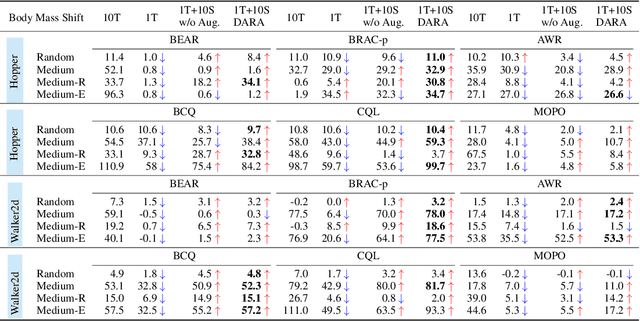


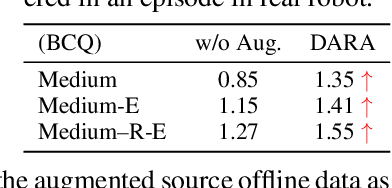
Abstract:Offline reinforcement learning algorithms promise to be applicable in settings where a fixed dataset is available and no new experience can be acquired. However, such formulation is inevitably offline-data-hungry and, in practice, collecting a large offline dataset for one specific task over one specific environment is also costly and laborious. In this paper, we thus 1) formulate the offline dynamics adaptation by using (source) offline data collected from another dynamics to relax the requirement for the extensive (target) offline data, 2) characterize the dynamics shift problem in which prior offline methods do not scale well, and 3) derive a simple dynamics-aware reward augmentation (DARA) framework from both model-free and model-based offline settings. Specifically, DARA emphasizes learning from those source transition pairs that are adaptive for the target environment and mitigates the offline dynamics shift by characterizing state-action-next-state pairs instead of the typical state-action distribution sketched by prior offline RL methods. The experimental evaluation demonstrates that DARA, by augmenting rewards in the source offline dataset, can acquire an adaptive policy for the target environment and yet significantly reduce the requirement of target offline data. With only modest amounts of target offline data, our performance consistently outperforms the prior offline RL methods in both simulated and real-world tasks.
 Add to Chrome
Add to Chrome Add to Firefox
Add to Firefox Add to Edge
Add to Edge